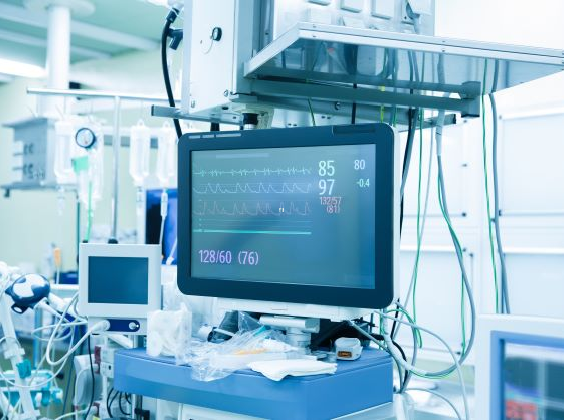
Written by

Cranfield, UK, 28th March 2024, Written by Kelly Patrick –
In this monthly news round up, I offer insights into some of the trends the team recently saw at the HIMSS event in Orlando, including my thoughts on the implications for the market.
1. Clinical Care – If we build it – they will come
Interoperability, device integration and data workflow in the clinical setting were key topics that were explored on vendor booths in addition to exhibit talks. The growing concerns around healthcare resource constraints and the need to simplify workflow to ease pressure on staff was a clear driver behind many of the developments exhibited at the show. The importance of data continuity and the streamlining of information integration was highlighted in the wake of the pandemic. Healthcare vendors have subsequently expediated their development of solutions that enable full disclosure of patient status.
The highlight for the clinical care team was the Interoperability showcase. The showcase itself was overflowing with vendors not only displaying their own connected solutions, but also demonstrations of how many of these devices fit within wider healthcare ecosystems. The IEEE 11073 service-oriented device connectivity (SDC) standard was the focus of a stakeholder discussion in which standard-driven bi-directional communication between devices, as opposed to the more traditional point-to-point (driver-based) communication, was a core topic. Philips, Draeger, Getinge and B Braun all discussed their involvement and provided their opinion on how the SDC will develop in the coming years to become a key standard in enabling a smart generation of healthcare.
In the short-term, regulatory (particularly FDA) approvals and cyber-security concerns will act as stumbling blocks. In the long-term, however, the implementation of SDC will enable AI-based closed-loop therapies and remote alarm management and delegation, leading to improved patient outcomes and a more efficient use of clinical resources. With approval of the SDC expected in the next 2-4 years, the likelihood of a smart ICU will soon be a reality in the not-too-distant future. For healthcare providers not yet ready to fully embrace SDC, discussion participants emphasised the standard can still be used unidirectionally in the short term but by implementing it they will be future proofing their organisations.
2. Workflow automation – keep it simple
Elsewhere in the exhibit hall, there was a key focus on solutions that enable workflows to integrate information at the point of care to validate the patient status and to improve efficiency. Vendors highlighted the developments that they had made to automate processes to reduce unnecessary tasks to help ease the burden on healthcare resource. Examples included using RFIDs and single-sign-on identification at the point of care to reduce unnecessary administrative tasks. AI-based analytics are also being used to identify patient status changes as early as possible to alert care givers to potential patient deterioration. Vendors such as Spacelabs, Nihon Kohden, Mindray, GE HealthCare and Philips exhibited their take on how they have taken analytics and applied it to the clinical setting to help improve patient management.
Beyond the interoperability showcase, Philips highlighted its ability to provide end-to-end solutions across the clinical markets. The acquisition of Capsule Technology has further aided the company to streamline both clinical and data workflow to enable real-time analysis of crucial patient information. The integration of BioTelemetry and Cardiologs into the wider monitoring and cardiac and monitoring portfolio has further extended Philips ability to enable at home monitoring.
Upon acquisition of PeraHealth in 2023, Spacelabs integrated the Rothman Index into its portfolio. The Rothman Index predictive analytic solution combines vital patient information to identify is a patient is at risk of deterioration. Whilst at the show, the Signify Research team heard first-hand how the index is helping to improve efficiency and improve workflow in the clinical setting. Having the opportunity to assess vital patient information and prioritise those patients at risk has resulted in quicker reaction and detailed insight into possible triggers to deterioration.
Late last month, Biofourmis and GE HealthCare announced their collaboration to extend patient monitoring outside the hospital. GE HealthCare’s booth demonstrated how the collaboration has extended both companies’ expertise in patient monitoring to connect their in-hospital journey through to the home. Earlier in the year GE HealthCare also announced it had agreed to become the exclusive distributor for AirStrip in the United States, further cementing GE HealthCare’s ‘FlexAcuity’ patient monitoring campaign. With sustained demand among clinicians for easy-to-use, intuitive solutions that can maximise workflow efficiencies, deals like this will be expected to continue through 2024.
Whilst many of the more established patient monitor vendors have built on their in-hospital solutions through the partnership and acquisition of home-based providers, Masimo recently announced that it has decided to spin off its consumer business. Despite the recent developments of its Stork baby monitor and the Freedom smartwatch, it has decided to redivert its focus on improving the profitability of its healthcare unit the professional healthcare and telehealth products. By taking alternate route to market than many of its peers. It will be interesting to see whether this will be a pivotal growth intersection for the vendor that has been the gold-standard for pulse oximetry for decades.
3. Robotics takes a leap of faith in the Emergency Services
On a separate side note, it was very hard to miss the presence of the cute and cuddly dog that was competing for attention with its robotic counterpart. AT&T’s partnership with FirstNet exhibited their robotic dog, developed to provide a connected response for the Emergency Medical Services. The robotic dog utilises IoT such as beyond visual line of sight (BVLOS) operational command and control to enable remote deployment and monitoring. The FirstNet dogs, equipped with wireless cameras, are already in use with the military.
Elsewhere the emergence of robotics was also present in the telehealth space with the use of ‘robots’ to help connect patients with remote care providers. An example was seen as Ava Robotics demonstrated how its Ava robot can facilitate access to patients providing remote care and help to redefine the dynamics of family visitation in healthcare facilities.
On a similar note, Tytocare has been actively adding new parameters to its Smart Clinic solution with a recent FDA approval for its wheeze detection. The Tytocare Smart clinic solution enables remote examination of eight core parameters to reduce the need for primary care or hospital visits, especially in patients identified as at risk of frequent visits to an emergency department. The company has two options targeted to the home for virtual care and the clinic to assess patient health remotely with medical-grade solutions. It is hoped with further uptake of the solution, the cost of healthcare will be reduced.
A deep dive insight into the trends that the Digital Health, Imaging IT and Clinical Care teams saw at the show is also available, providing highlights for the core areas.
Signify Research’s most recent reports include new analysis on the Infusion Pumps, Fetal Monitors, AI in Diagnostic cardiology and Hospital-At-Home markets. We also have several new reports publishing soon:
- Ventilators available in May.
- Patient Monitors available in May.
- Diagnostic Cardiology available in May.
We welcome further conversations on the trends specifically impacting the markets highlighted.
Did you find this round-up useful? Subscribe to Signify Research’s monthly newsletters to get immediate access to some of our more in depth market related insights.
About Kelly Patrick
Kelly joined Signify Research in 2020 as a Principal Analyst. She has over 15 years’ experience covering a range of healthcare technology research at IHS Markit/Omdia. Kelly’s core focus has been on the Clinical Care sector, including patient monitoring, diagnostic cardiology, respiratory care, and infusion and associated IT solutions. Kelly holds a BSc degree with honours in Pharmacology from the University of Leeds. In her spare time, Kelly has a passion for running and outings with her husband and three children.
About Gareth Jones
Gareth joined Signify Research in 2021 as Senior Market Analyst in the Digital Health team, where he covered emerging markets including Remote Patient Monitoring (RPM) and Ambulatory Diagnostic Cardiology. In 2023, Gareth joined Signify’s Clinical Care team where, his coverage areas include Diagnostic Cardiology and Patient Monitors.
About Sam Wilson
Sam Wilson joined Signify Research in 2023 as a Market Analyst within the Clinical Care team. He brings experience working as an Economist for the Intellectual Property Office, creating strategy reviews and impact evaluations, used to aid government trade negotiations. Sam holds a first-class bachelor’s degree in economics from Loughborough University, where modules included topical issues such as healthcare. Away from the office Sam enjoys staying active with dog walks, football and cricket, and his interest in volunteering took him on a charity visit to Ethiopia.
About the Clinical Care Team
The clinical care team provides market intelligence and detailed insights on the clinical care equipment and IT markets. Our areas of coverage include patient monitoring, diagnostic cardiology, infusion pumps, ventilators, anaesthesia devices, and high-acuity IT. Our reports provide a data-centric and global outlook of each market with granular country-level insights. Our research process blends primary data collected from in-depth interviews with healthcare professionals and technology vendors, to provide a balanced and objective view of the market.
About Signify Research
Signify Research provides healthtech market intelligence powered by data that you can trust. We blend insights collected from in-depth interviews with technology vendors and healthcare professionals with sales data reported to us by leading vendors to provide a complete and balanced view of the market trends. Our coverage areas are Medical Imaging, Clinical Care, Digital Health, Diagnostic and Lifesciences and Healthcare IT.
Clients worldwide rely on direct access to our expert Analysts for their opinions on the latest market trends and developments. Our market analysis reports and subscriptions provide data-driven insights which business leaders use to guide strategic decisions. We also offer custom research services for clients who need information that can’t be obtained from our off-the-shelf research products or who require market intelligence tailored to their specific needs.
More Information
To find out more:
E: enquiries@signifyresearch.net
T: +44 (0) 1234 986111
www.signifyresearch.net
